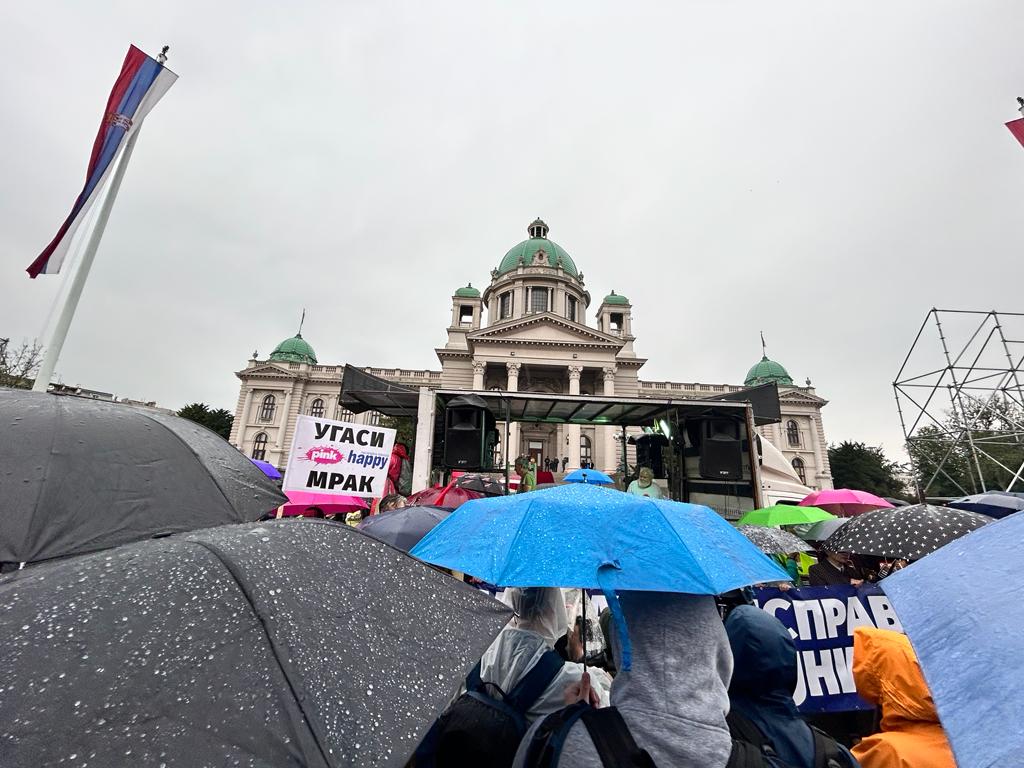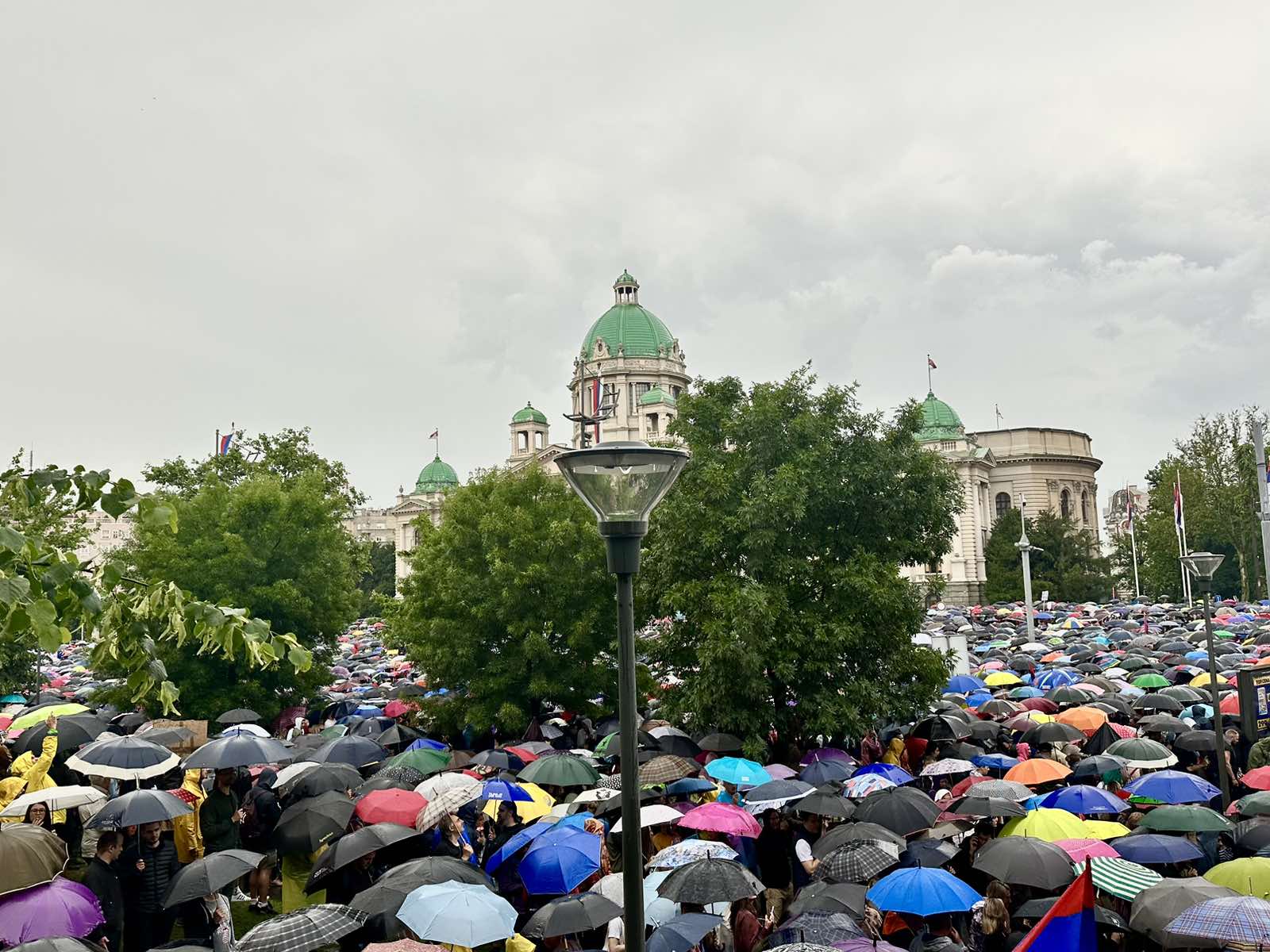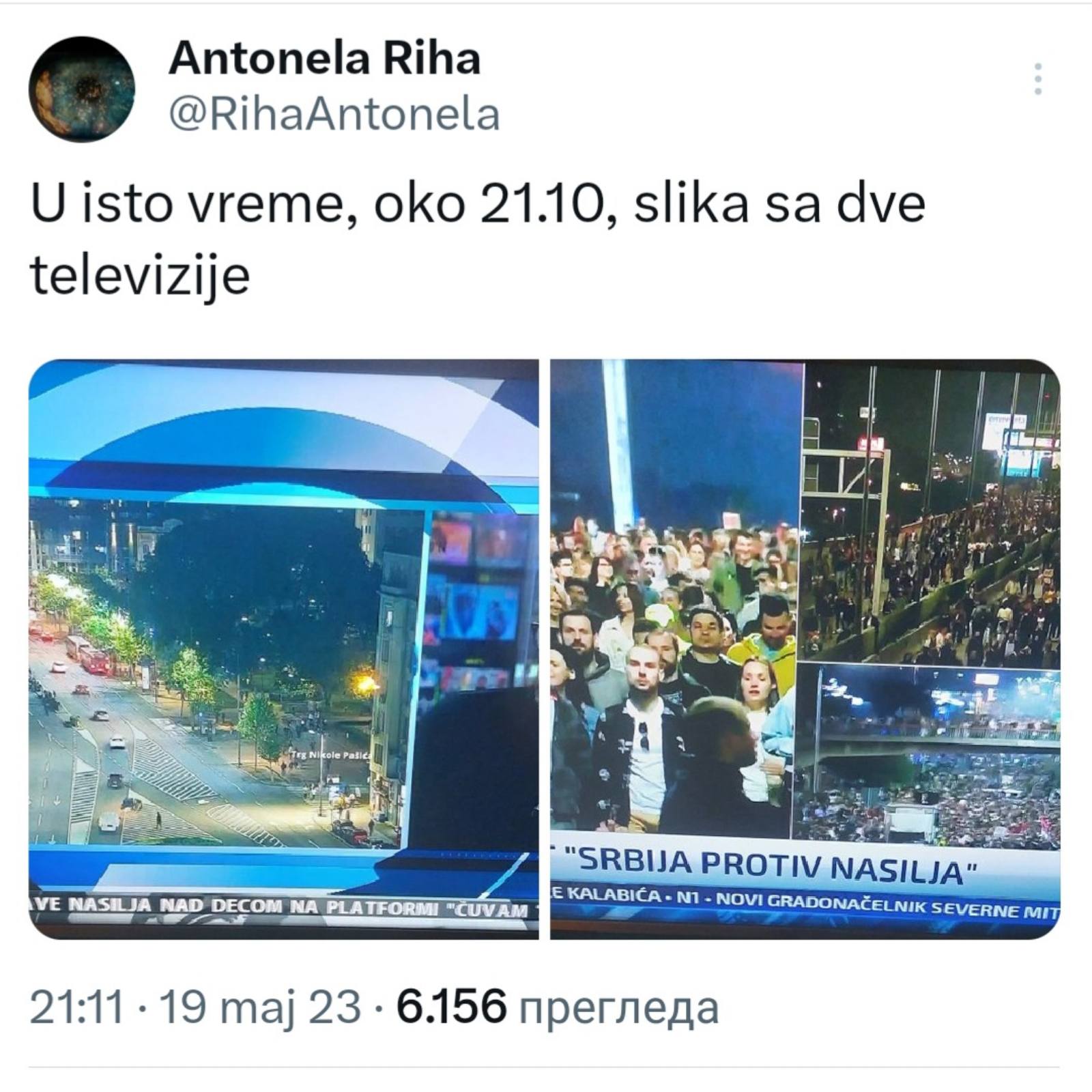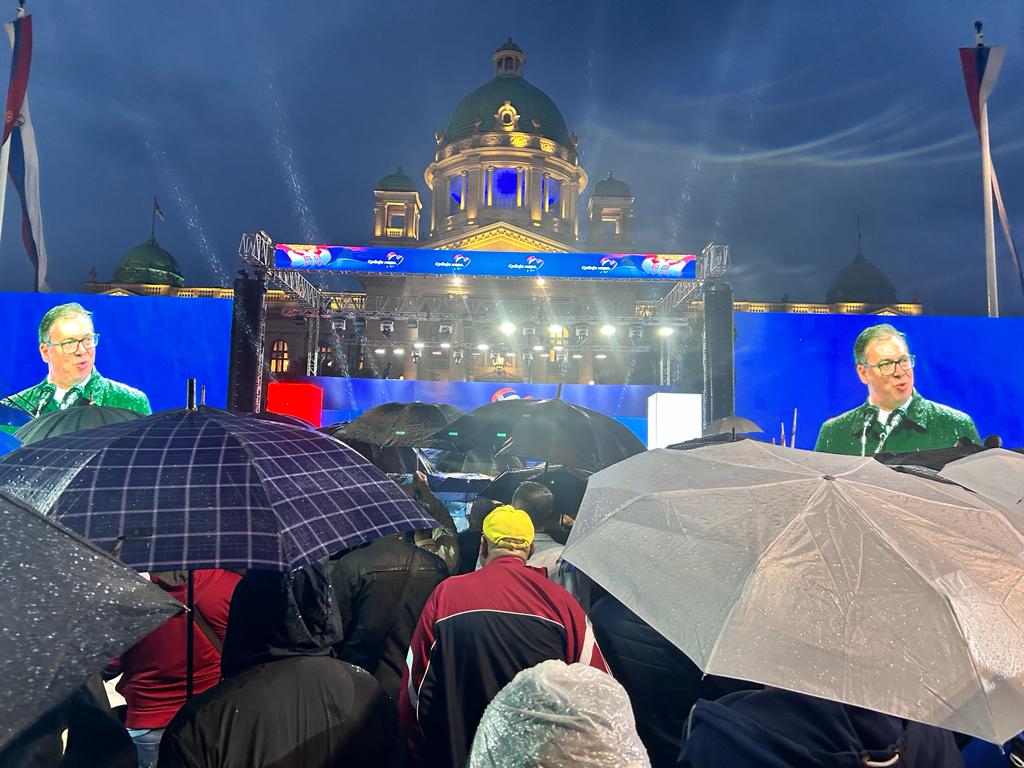Belgrade, during the protest demonstration of 27 May 2023 (photo M. Moratti)
Under the pressure of a public opinion that takes to the streets every week and actively protests in front of the institutional seats of power, the regime of Aleksandar Vučić begins to creak, so much so that the president has resigned from the leadership of the party he helped found
On Saturday 27 May, Serbian President Aleksandar Vučić left the leadership of the Serbian Progressive Party (SNS), announcing that at the end of June he will take the reins of a new political formation, called Movement for the People and the State, which will also include the SN extension. Although it has been interpreted in various ways, it is clear that Vučić’s decision is a consequence of the crisis of the current regime, characterized by the tendency of the Serbian president to take political decisions without consulting anyone and only when he is under pressure, as well as by a strong propensity to authoritarianism.
To replace Vučić at the helm of the SNS is a loyalist of his, Miloš Vucevic , who was mayor of Novi Sad for years and currently holds the position of defense minister. In his first statements after being appointed to lead the SNS, Vučević repeated the words of President Vučić, who, reacting to the opposition’s demands, said he was willing to discuss possible early elections, but not a government of transition. The new leader of the SNS is expected to continue repeating the words and aligning himself with the decisions of President Vučić, also considering the probable transfer of the center of power from the SNS to the new movement announced by Vučić.
This political ploy is interpreted as yet another populist move by the Serbian president who, by creating a new movement, hopes to resolve the internal crisis in the SNS and, at the same time, to carve out room for maneuver that will allow him to be re-elected for a new mandate and to become the backbone of a future majority.
Resigning from the leadership of the SNS, Vučić declared that from now on he will be “the president of all citizens of Serbia” and called on the opposition to dialogue. However, it seems that Vučić chose the wrong moment to launch this message, considering the demands of the citizens, who have been protesting for three weeks now, and those of the opposition who have joined the street protests.
Vultures and hyenas
After two massacres that shocked Serbia in early May, many citizens gathered to express their condolences in a commemorative procession. Vučić and his collaborators, using the regime’s media as a megaphone, called the participants in the procession with derogatory names, accusing them of wanting to destroy the Serbian state and government with violence.
The inopportune reactions of power have prompted citizens to take to the streets again. The protest, under the slogan “Serbia against violence”, grew week by week, demonstrators blocked the highway and one of their demands was granted, that of dismissing Education Minister Branko Ružić due to massacre that took place in an educational institution in the center of Belgrade where a boy killed nine of his peers (a girl died a few days after the shooting from her injuries) and a janitor.
After the second massacre – in which nine young people were killed in two villages near Mladenovac, a short distance from Belgrade – it emerged that the killer was already known to the police, possessed illegally held weapons, but evidently enjoyed the protection of some powerful local.
After the first protest demonstration, the opposition sent their own requests to the government. In addition to the dismissal of the education minister, who has resigned in the meantime, calls are made for the removal of interior minister Bratislav Gašić and the head of the BIA (Serbian secret services) Aleksandar Vulin. The opposition is also calling for a ban on media and programs that promote violenceseeing precisely in the media contents that daily encourage hate speech and criminal and violent acts one of the causes of the phenomenon of mass murders.
On May 19, tens of thousands of citizens again marched through the streets of Belgrade, blocked the highway, and then dispersed peacefully, determined to continue the protest. While independent media showed an endless stream of people, reporting that it was the largest protest rally since Vučić’s rise to power, the regime media, as usual tried to downplay the event, and broadcaster Pink even went as far as to claim that the bridge was “blocked by some random passers-by”.
Power reacted hysterically. President Vučić called the demonstrators “vultures and hyenas”, the prime minister did nothing but repeat Vučić’s words and the regime’s media echoed them. As the political confrontation intensified, the issue of the killed young people faded into the background. Vučić then decided to fight back, and already the following week, on 26 May, he organized a counter-demonstration called “Serbia of hope”, announcing it as “the largest rally in the history of Serbia”.
A fiasco
Hundreds of buses from all over Serbia, but also from Republika Srpska, North Macedonia and Kosovo poured into Belgrade early in the morning on Friday 26 May. The whole country was mobilised, several school trips were canceled in order to have a sufficient number of coaches available, even engaging some Bulgarian and Kosovan transport companies. In the midst of the crisis between Pristina and Belgrade, Kosovar Albanians transported Kosovo Serbs to Belgrade.
Employee lists were drawn up in public bodies all over Serbia, each local trustee of the SNS had the task of rounding up a certain number of people who would travel to Belgrade. In Niš, the premiere of a theater show was even canceled because the mayor came to the conclusion that citizens, rather than going to the theatre, would have preferred to attend Vučić’s rally. In some educational institutions, classes ended earlier than scheduled to allow students and teachers to say goodbye to the president.
From the early afternoon, the whole of Belgrade was blocked, traffic stopped, thousands of people headed towards the center where speeches by Vučić and TV Pink programs were broadcast on giant screens. Then suddenly a succession of thunders was heard, a storm hit the city with pouring rain that persisted for hours. The streets were completely flooded and even before the rally began most of the citizens dispersed in search of shelter. Vučić went on stage, threw down his umbrella and, all wet, gave a speech in which, among other things, he announced his intention to leave the leadership of the SNS.
“We are preparing to create the Movement for the People and the State as a starting point for saving our country in the next two to three years that will be crucial for our state,” Vučić said addressing the citizens, before concluding: “ Thank you so much, I have no words to describe how much I love you.”
There is no rational reason behind Vučić’s decision to organize a counter-demonstration. Faced with completely unexpected mass protests that erupted after the recent massacres, Vučić probably wanted to reconfirm his power and demonstrate that he is a statesman and an undisputed authority. However, the storm showed that tens of thousands of people from all over the country traveled to Belgrade because they were forced to, fearing they would lose their jobs if their name did not appear on that list which grants some small benefit to obedient and their families. Thousands of Vučić’s true supporters also took part in the counter-demonstration, but they too returned home wet and numb, and this is probably the most intense image of that day.
Waiting for an epilogue
Already the following day, Saturday 27 May, citizens and opposition leaders took to the streets again to protest. Despite the pouring rain, a very long procession of people marched through the central streets of the capital, to then stop in front of the headquarters of Radio and Television of Serbia (RTS) to express their discontent with the way in which the country’s most followed broadcaster does information. Protesters have announced that the protest will continue until their demands are met.
Meanwhile, in the north of Kosovo, inhabited mostly by Serbs, new incidents have occurred. On Friday 26 May, in the four municipalities with a Serbian majority (Zvečan, Zubin Potok, Leposavić and northern Mitrovica) clashes after Serbs tried to prevent newly elected mayors of Albanian nationality from taking up residence in municipal buildings.
On the same day, Vučić ordered the Serbian army to raise the alert level to the highest level and to deploy troops along the border with Kosovo.
Over clashes that occurred in Serbian municipalities in northern Kosovo more than 50 Serbs and 30 KFOR soldiers were injured by throwing stun grenades, stones and tear gas. On Tuesday 30 May, the political representatives of the Kosovo Serbs (the Srpska Lista) urged citizens not to endanger the safety of KFOR soldiers, because if they were to do so, they would be acting against the interests of the Serbian people.
The crisis in Kosovo continues in parallel with the negotiations between Belgrade and Pristina. Kosovar Prime Minister Albin Kurti is trying to take control of the northern part of the country after the local elections which were boycotted by the Serbs, with the support of Belgrade. The boycott of the elections is a consequence of the Serbs leaving all institutions in northern Kosovo, including the police, in protest against the decision of the Pristina government to impose the obligation to replace Serbian-issued license plates with Kosovar ones .
In this vacuum, where there are neither institutions nor authorities and a definitive solution to the Kosovo issue still seems far away, any clash, regardless of the reason, can be dramatic.
At the same time, however, similar situations allow Vučić to buy time in Belgrade, opening up a space for maneuver in which the Serbian president can manipulate the citizens’ fear and create a warlike atmosphere, thus diverting attention from street protests and opposition requests.
Have you thought about a subscription to OBC Transeuropa? You will support our work and receive preview articles and more content. Subscribers to OBCT!




